It is safe to say that it is common knowledge that housing played a huge role in the recent recession and financial crisis. And although that sector has stabilized, it is not yet really contributing to overall economic growth. Nonetheless, housing is not seen by most economists as pulling the economy into a double dip recession. In contrast, many are concerned that commercial real estate is worsening and could undermine profits for banks holding related debt as well as spoil overall economic growth. A look at growth in various portions of the construction sector can give some perspective on risks from commercial real estate as well as from other subcomponents.
The most comprehensive, timely, and moderately detailed data on current construction activity likely come from the Bureau of the Census’ construction expenditures report, Value of Construction Put in Place. The main components are private residential, private nonresidential, and public (which is broken down into federal and state & local government). For simplicity, we will omit “private” for the category names of residential and nonresidential outlays. There are series that combine the related residential and nonresident series from public sector and private sector spending but here we are separating public and private data sets.
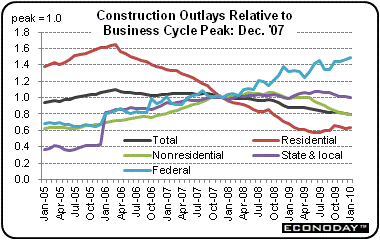 One way of looking to see whether there was significant overhang heading into the recession that officially started December 2007 is to index construction outlays for each series to the most recent business cycle peak. That is, each month’s data value is divided by the value of that series for December 2007. This is shown for key construction outlays series in the adjacent chart. One way of looking to see whether there was significant overhang heading into the recession that officially started December 2007 is to index construction outlays for each series to the most recent business cycle peak. That is, each month’s data value is divided by the value of that series for December 2007. This is shown for key construction outlays series in the adjacent chart.
What stands out from this chart is the rapid run up in residential construction prior to the recession. And that subcomponent started to dive well before the overall economy did at the end of 2007. Residential construction rose rapidly until early 2006 when it hit a level that was over 60 percent higher than where it would be when the overall economy tipped into recession during December 2007. From the cycle high in March 2006 to the cycle bottom in June 2009, residential outlays plunged 65 percent.
How have other components fared' The two public sector components offer a sharp contrast. Although the federal and the state & local outlays components were rising moderately through the end of expansion, the state & local component slowed sharply during recession and recently turned negative. In contrast, fiscal stimulus has kept federal construction spending on a sharp uptrend. As of January 2010, the state & local component had slipped back to being equal to the level of activity at the start of recession. Meanwhile, the federal component was 49.1 percent higher than at December 2007!
Nonresidential construction did grow at a healthy pace during the past expansion. For December over December, nonresidential outlays were up 6.4 percent in 2004 and up 9.4 percent in 2005. For those same years, residential outlays jumped 12.5 percent and 17.2 percent, respectively. Thereafter, housing was dropping. Meanwhile, nonresidential spending did post stronger gains of 18.1 percent in 2006 and 25.4 percent in 2007 before slowing to a standstill in 2008 and declining 20.1 percent in 2009. Clearly, nonresidential construction was late to the recession party. As of January 2010, residential outlays were down 20.1 percent from when the most recent recession started while nonresidential outlays fell 20.9 percent over the same period. But to get a full perspective, one actually needs to go back to the prior business cycle which peaked in March 2001.
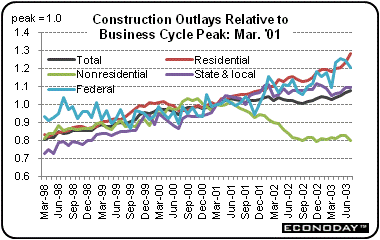 The 2001 recession was a mild one. Yes, industrial production and employment declined moderately, but most construction components barely skipped a beat due to the brevity of the recession and the Fed keeping interest rates extremely low. Residential outlays – a typically very cyclically sensitive series – fell only slightly and actually before the official start of recession. Federal and state & local construction outlays continued their uptrend through the recession. In contrast, nonresidential construction fell sharply and set a very low baseline for growth during the following expansion. The low baseline explains in part why nonresidential outlays eventually rose strongly just prior to the onset of the 2007-2009 recession. While nonresidential outlays did post strong gains in 2006 and 2007, the resulting overhang created by recession does not appear to be as serious as that built up for housing. The 2001 recession was a mild one. Yes, industrial production and employment declined moderately, but most construction components barely skipped a beat due to the brevity of the recession and the Fed keeping interest rates extremely low. Residential outlays – a typically very cyclically sensitive series – fell only slightly and actually before the official start of recession. Federal and state & local construction outlays continued their uptrend through the recession. In contrast, nonresidential construction fell sharply and set a very low baseline for growth during the following expansion. The low baseline explains in part why nonresidential outlays eventually rose strongly just prior to the onset of the 2007-2009 recession. While nonresidential outlays did post strong gains in 2006 and 2007, the resulting overhang created by recession does not appear to be as serious as that built up for housing.
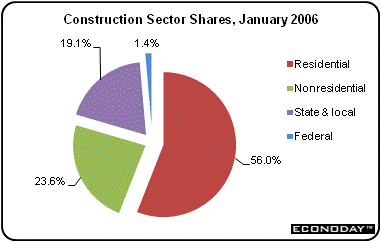 Since before the latest downturn, there have been notable changes in component shares. In January 2006, the majority of construction was for the residential component with a 56.0 percent share. Second was nonresidential at 23.6 percent with state & local coming in third with a 19.1 percent share. Federal construction was a tiny 1.4 percent. Since before the latest downturn, there have been notable changes in component shares. In January 2006, the majority of construction was for the residential component with a 56.0 percent share. Second was nonresidential at 23.6 percent with state & local coming in third with a 19.1 percent share. Federal construction was a tiny 1.4 percent.
 The sharp drop in residential outlays over the next four years led to a sizeable shift in component shares of total construction spending. First, the residential component plunged to 29.5 percent. This by itself led to other components taking bigger portions of the pie with nonresidential now up to 35.8 percent and state & local gaining to 31.2 percent. It is still relatively small but the federal government share more than doubled to 3.5 percent on the shrinkage by housing and on actually higher levels of spending by the federal government. Going forward, the nonresidential component has a bigger share of construction to weigh on the economy but its portion is still nowhere near that of residential outlays prior to its latest decline. The sharp drop in residential outlays over the next four years led to a sizeable shift in component shares of total construction spending. First, the residential component plunged to 29.5 percent. This by itself led to other components taking bigger portions of the pie with nonresidential now up to 35.8 percent and state & local gaining to 31.2 percent. It is still relatively small but the federal government share more than doubled to 3.5 percent on the shrinkage by housing and on actually higher levels of spending by the federal government. Going forward, the nonresidential component has a bigger share of construction to weigh on the economy but its portion is still nowhere near that of residential outlays prior to its latest decline.
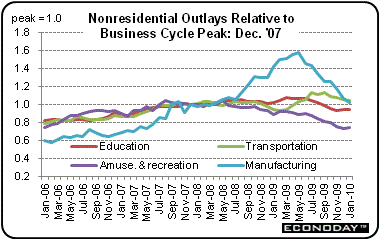 There has been a wide range in trends for the nonresidential major subcomponents. Manufacturing actully continued to rise sharply through mid-2009. This helps to explain in part why the capacity utilization rate hit a record low in June 2009. And since mid-2009, construction outlays for manufacturing have been declining but still are barely above levels just prior to recession. There has been a wide range in trends for the nonresidential major subcomponents. Manufacturing actully continued to rise sharply through mid-2009. This helps to explain in part why the capacity utilization rate hit a record low in June 2009. And since mid-2009, construction outlays for manufacturing have been declining but still are barely above levels just prior to recession.
A subcomponent that held up well until just recently was education which is construction for private education facilities. Transportation construction also fared reasonably well, oscillating moderately over the past two years. But declining moderately since the end of the expansion is the amusement & recreation subcomponent which was down 25 percent from December 2007.
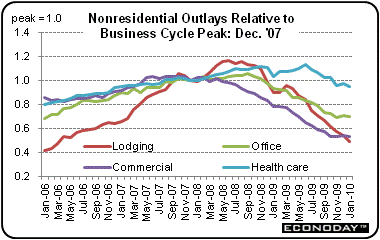 The final subcomponent of nonresidential spending that held up during recession was health care. Construction actually continued an uptrend until mid-2009 before slipping. The final subcomponent of nonresidential spending that held up during recession was health care. Construction actually continued an uptrend until mid-2009 before slipping.
The subcomponents that have fared the least well are office, commercial, and lodging. The worst are the latter two with commercial down 47 percent from December 2007 to January 2010 while lodging is down 51 percent. Commercial is defined by Census to include automotive (dealerships, repair, and parking), food & beverage, multi-retail (including shopping centers and malls), warehouses, and other commercial (includes drug stores and building supply)
Nonresidential construction has begun to weigh on the recovery and likely will continue to do so in coming months as vacancy rates remain somewhat high and lending remains tight. The good news is that this sector is not likely to fall out of bed as badly as housing did early and is not likely to pull the overall economy back into recession. But this still is an area to watch out for in terms of bad loans which lead to write-offs by lenders and losses for bank stocks.
|

